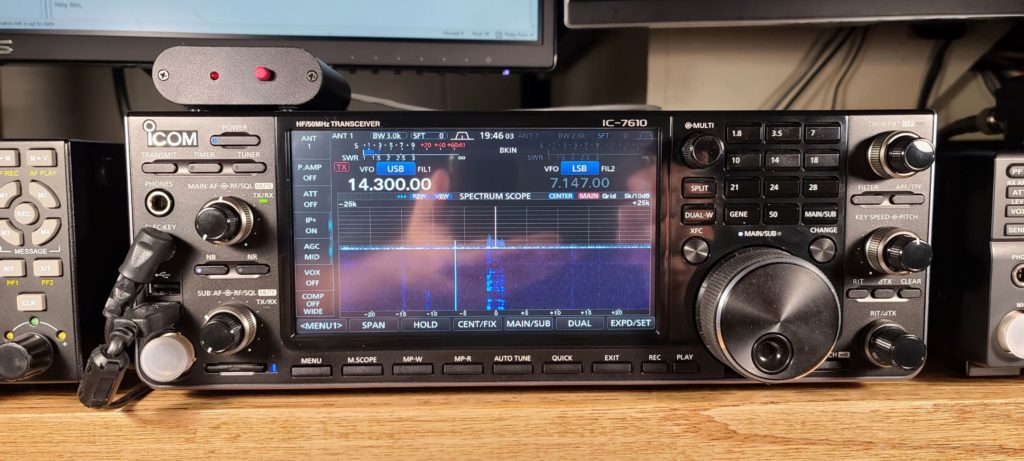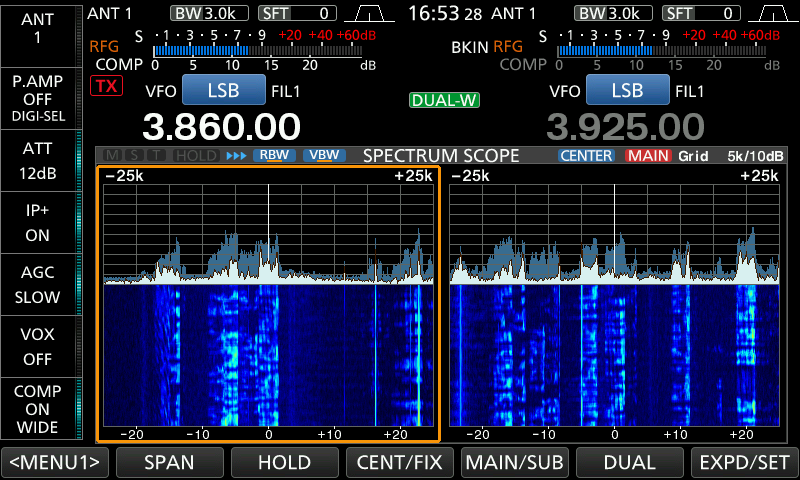In February 2020 I ordered an Icom 7610. This article is about what I like, what I don’t like, and my overall opinion on the radio. If you are interested in this radio, you will find some excellent information and resources herein.

Why I bought the 7610
When I started looking at the middle tier for a new radio, I found these four: the Elecraft K3S, the Yaesu FTdx101D, the Kenwood TS-890S, and the Icom 7610. All of these radios have a lot of features and each of them attempt to cater to a different interest in their own way.
It is now common practice for manufacturers of ham radio equipment to make the manuals and usually a lot of other supporting documentation available online. This is a great way to get to know a piece of gear before you buy it. It’s no replacement for trying one out, but it’s better than nothing.
After reading the manuals for all four of the above mentioned radios and weighing out which options were a priority for me, I opted to get the 7610. Some of the main reasons were:
- The 7610 was the cheapest of all the mentioned radios by several hundred dollars at least.
- Direct sampling SDR, the latest and greatest.
- Actually has three independent VFO’s using HDSDR for the third receiver on your computer.
- It’s physically small, only the K3S was smaller. The TS890S and the FTdx-101D are both quite a bit larger.
- It looks really nice.
What I like(d) about the 7610
There is a lot to say to the positive on this radio but lets start with ergonomics: they are excellent.
From the 7″ touch screen to the multi function rotary knob, navigating the radio is very intuitive. If you can use a modern smart phone or tablet, you will feel right at home with this interface.
Appearance: If I haven’t already mentioned it, the radio is very attractive. The screen is excellent as is the overall appearance. There is a really nice “ICOM” stamped into the top cover as well.
The panadapter is huge and excellent. It’s hard to operate without it once you become accustomed.
Flexibility: This radio has a ton of I/O on it. Transverter, External reference, Ant in/out, USB2, USB3, Ethernet, two ACC ports, ALC in, Key out, KEY in, Paddle in, two front panel USB ports which support the RC-28 remote VFO or a mouse and keyboard, etc. Neat things you can add to the 7610: External Buttons for the internal memories and awesome External Meters and more.
Dual Watch: This has long been present on Icom radios and allows you to listen to two different frequencies at the same time. These frequencies can be in the same band, a different band, or even with a different receive antenna.
Diversity Reception via discrete ADC’s: locks the two VFO’s together with a different antenna on each. This is a very interesting feature, it’s main advantage is to combat fading from shifting polarity. This will work best with two different antenna configurations: one dipole and one vertical for example. If you are a net control, you might also use this to have an omni directional antenna on one vfo, and a beam on the other to hear the weak ones.
Dual analog to digital converters standard. Several radio’s in this class only ship with a single ADC onboard. Flex Radio uses the term “slices” but this is to hide the fact that the radio only has one ADC. You have to spend more on the Flex Radio to get the model with two ADC’s. The Elecraft K4, which is considerably more expensive, also ships with only one ADC.
While were talking about other radios in the price class, several of them (including both mentioned above) also ship without a built in tuner. While it won’t win any awards, the built in tuner in the 7610 works quickly and quietly up to about a 3:1 mismatch in my experience. There is an emergency mode where it can match up to 10:1 but only with reduced output. That is one of those scratch your head features IMO.
A feature that many will wonder about is the DIGI-SEL pre-selectors. These are basically adjustable tuning networks that can help reduce problems from strong adjacent signals. Proper adjustment here will take the strain off the ADC’s and allow for reducing some QSB as well. After initially using the DIGI-SEL on the low bands, I found I could achieve the same by reducing RF gain in all but extreme cases.
I liked the fact that when it was discovered that there were failures with the LCD screens, ICOM made good on it and replaced them for free regardless of the radios warranty status.
What I didn’t like about the 7610
The comments that follow should be looked at with the understanding that none of them is a real deal breaker. I could have kept the radio and been happy for the most part. But there are a few things…
Well, the biggest thing I didn’t like was that my screen went bad. I had to spend over $120 to ship this radio to the Icom repair center in Washington State. They fixed the screen, but I was without my radio for about a month.
Another thing I didn’t like was that the Preamp 1 failed. This is a fairly common problem as I would learn. Icom repaired this under warranty when I sent the rig in for a new screen. My radio was a few weeks out of warranty but they fixed it anyways.
The warranty is only one year. Warranties should generally be longer at this price point in my opinion. Three years is pretty standard for Automobiles and they are a lot more complicated. Just saying…
Transverter operations: The transverter support in the 7610 is pretty basic to say the least. There is only configuration for a single transverter and they are very limited. Basically all you can do is set the frequency offset and transverter on or off. You cannot use the transverter on one VFO while monitoring HF on the other. The transverter function takes over the entire radio. You can listen to two different frequencies (like 44.200 on VFO-A and 46.520 on VFO-B) on your single transverter however. The display does not display the full converted frequency. In my case I have a 2 meter transverter so the display would read: 44.200 instead of 144.200. You could use more than one transverter and do the frequency offset in your head but really, my ANAN-7000 DLE MKII can configure and use 14 separate transverters and mix and match them with HF at will. The Elecraft K3 will configure and integrate up to 10 so there is definitely room for improvement on the transverter support in the 7610. There is also virtually no documentation on this in the manuals.
Receive audio quality. This one will be highly subjective. Even though the radio has a nice clean sound, and I have pulled in many weak stations with this rig, I grew weary after long sessions of listening to the 7610. I tried several different configurations but the fatigue always returned. Built-in speaker, Palstar SP30H, Heil powered speakers, USB audio direct to the PC, and so on.
No receive or transmit EQ: This is present on most radios in this class, it may have helped with the previous thing I didn’t like. The 7610 only offers bass and treble controls.
Diversity Receive: Your not imagining things, this was also listed under things I liked. So why didn’t I like it? Other than being able to select the diversity mode, which locks the VFO’s together for frequency tracking, diversity cannot be configured in any meaningful way. Other radios with diversity allow for using the second antenna for active noise canceling along with the more basic function.
No programmable buttons: Why does Icom hate programmable buttons? Kenwood and Elecraft each have several buttons on their radios that can be assigned to menu items for quick access. Icom? Nope. That’s alright you say, you can add an external controller for that. Nope, the external buttons are only for the built in CW and Voice memories. LAME.
No software included: You have to pay $150 more for the companion software. Kenwood, Elecraft and Apache come with free software. In the case of the Apache, it’s even open source.
Keyboard and Mouse: The ability to use a keyboard and mouse is nice but as is the theme throughout, it’s severely limited in application. You can use the mouse to click inside the panadapter, but that’s all. It does not work outside of the panadapter itself. IE: you cannot scroll the frequency or change the modes etc.
Final Thoughts
So in closing I’d like to say the IC-7610 is a very fine radio. If after reading this you didn’t find any of this to be much of an issue, then by all means get one and enjoy it!
I’ll finish this with a few resources that will help get maximum enjoyment from your 7610.
- Start here, read thoroughly.
- The best place to get help and information on the 7610 is the Groups.io reflector.
- Learn to manage the noise floor correctly.
- A comparison between the 7610 and the TS-890S
In August of 2021 I sold the 7610. I did well on the sale and didn’t lose much. I may update this some more over time but this pretty much covers my feelings about the radio.
73! AB0R – 8-21-2021
